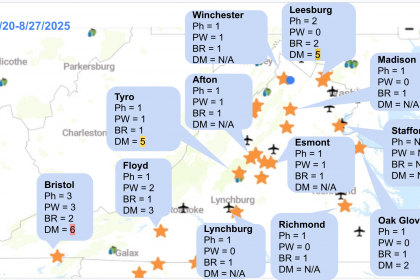Here’s a snapshot from the last week, showing the number of days with the risk of each disease: Ph = Phomopsis, PW = Powdery mildew, BR = Black rot, and DM = Downy mildew. (Note: Floyd station is out of order since early July. We are working with Rainwise to fix it.)

The image above is just a summary of the past 7 days. Please visit https://newa.cornell.edu/ to obtain more detailed information. You can check daily weather data as well as disease and insect pest model results including forecasted risks. We paid the annual fee so that growers in Virginia can freely access NEWA. Please take advantage of the resources. This information was made available through Wine Board-funded the Sentinel Vineyard project. We obtained NEWA weather stations that have been installed throughout the state.
It seems that we had another wet week with many thunderstorms passing through the area. More than a few days with downy mildew risks were observed at all weather stations in the past 7 days. If you are in an area where the number of days with downy mildew has been high, in the last several weeks, please consider protecting your vines with downy mildew material(s).
Having said that, the spray decision needs to be based not only on the weather condition but on the cultivar and history of the disease(s) in your vineyard. For example, if your vineyards have been clean and vines are protected from the previous application of fungicides, there is no need to make “rescue” sprays.
On the other hand, if you know you have seen a concerning level of downy mildew in the past, your spray was more than 10 days ago, and if you saw more than 2 inches of rain, it is probably a good idea to mix a phosphonate (i.e., a “phos acid”, such as Prophyt or Phostrol) for downy mildew.
Seasonal grape disease management reminders
At this point, our focus will be on powdery and downy mildew plus Botrytis at veraison, then we need to protect clusters from late-season rots. You can find specific materials information in this post (mid-season disease management), this post (VVA presentation), or this one (bloom time reminders).
I just want to point out that this year has been wet and the risk of downy mildew has been high for many areas throughout the season. I have received more than the usual number of reports from growers about downy mildew already. Toward the end of this month, the number of risk events tends to increase due to cooler and more humid night conditions.
Some of you prefer to use copper for downy and powdery mildew. I have used several formulations of copper in the past five years or so, and they worked very well against downy mildew. Many newer formulations are less prone to cause phytotoxicity, even when it was applied to a copper-sensitive cultivar. However, many winemakers are concerned about the use of copper and its negative impact at the time of fermentation. The same is true with captan, so, please make sure to communicate with your winemaker about when to stop the application of copper or captan. Typically, people stop using them ~ 3-4 weeks before harvest.
Other options for downy mildew are Ranman (FRAC 21, 30-day PHI), Revus/Forum (FRAC 40, 14-day PHI, but the risk of resistance is high), Zampro (FRAC 40 plus 45, 14-day PHI, note that one of the components is the same as Revus), and phos acid (FRAC P07, 0-day PHI). A phos acid material may cause phytotoxicity if you apply at a higher than recommended rate or mixed with copper. When we tested the combinations of copper and phos acid, the results are not consistent but we recorded an increase in the level of phytotoxicity, thus, in general, I don’t recommend using them together. If you are interested in mixing them, please contact me so that we can discuss some ideas.
Another early-season disease that may show up this time of the year is black rot. Berries are resistant to black rot infection at this point, so, you don’t need to take any special action against it. What you are seeing are most likely the results of infections that happened 3-4 weeks ago. If you have applied a DMI fungicide and still got black rot, please contact me.
There are several cases of early season Botrytis reported. At this point, I hope some of the early infection is gone, but it may not happen, knowing the wet condition we are experiencing. When you apply a Botrytis material at Veraison, please make sure to mix with captan or copper which has weak activity against Botrytis to lower the risk of fungicide resistance which is common with the Botrytis pathogen. As with the “at bloom” application, the “at veraison” application may last more than one application. You may need to apply twice to cover the beginning and the end of it (or to cover multiple cultivars).
Ripe rot protection happens at veraison too. Make sure to cover your berries around veraison and then one or two more applications in a 10-14-day interval. The number of applications will depend on your cultivar. For more details, please see the presentation here.
One more tip or reminder. This has happened to me too. Some of us forget to spray late-season cultivars when we start to harvest early-season cultivars. Please make sure to protect these cultivars against late-season diseases!





